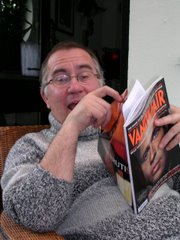In pictures: For the Love of God
In pictures: Selected works
Richard Dorment's review
Thursday, May 10, 2007. We are in Newport Street, London SE11. To one side is a non-descript row of light-industrial units, to the other the railway viaduct along which the Eurostar trains slow-sway their way through the somnolent southern suburbs bound for Paris. This bit of Lambeth seems like a scrag-end of the metropolis: implausibly close to the Neo-Gothic power station of Westminster and the Brutalist cultural blockhouses of the South Bank, yet a world apart.
Damien Hirst: 'We can't be humping about steel and glass when we're old; we'll have to make little wooden things'
Still, cities have long memories, bred in the brick. Within yards of here the Lambeth Pleasure Gardens once spread, with their contrived grottoes and pseudo-sylvan groves, their lightshows, water features and hidden string ensembles - a 17thcentury exercise in special effects. Near here, too, was Tradescant's Ark, London's first museum, where the eponymous antiquarian amassed a great wealth of animal bones, stuffed birds and exotica from far-flung cultures.
We are also in purlieus of Elias Ashmole, the alchemist - and collector - who's buried under a black slab in South Lambeth Church that proclaims his name will endure as long as his Oxford museum. And, of course, Lambeth is William Blake's London: the garden nudist, the visionary who drew the angels he saw doing synchronised swimming in time-goo. Blake, of whom it was once said, 'His work shows what a bad artist would be like, if he happened to be a genius.'
There, walking beside the railway arches in a knitted helmet - complete with earflaps - wearing a leather jacket with an iridescent skull across its shoulders, an off-white T-shirt with a dove motif on its breast, and half-arsed black bondage trousers (they look capable of confining only the seriously febrile), is the lineal descendant of Ashmole, Blake and Tradescant: Damien Hirst, the curator of his own museum, the artificer of pleasurable torture gardens, whose self-professed alchemical aim is to cheat death through the sheer chutzpah of his creations and his collecting. He's on the phone.
And stays on and off it for the remainder of the six hours we spend together. Interviewers remark on Hirst's phenomenal energy: his gourmand's attempt to ingest the world, quite as much as he vomits his art into it. Others who've met him have been bamboozled by his bewildering shifts of persona: from mechant Machiavellian, to ingenue, to idiot savant, to - in their purview - surprisingly well-educated discourser on the history of art and his place within it.
But I greet none of these, only Damien, whom I first met in 1994, then knocked about with a bit during what his friend - and art dealer - Jay Jopling describes, not a little ironically, as 'the glory years'; that heady period in the mid to late 1990s when, so far as Hirst and his peers were concerned, the kaleidoscope had been shaken and the pieces were in flux. Before they settled, Hirst et al made to re-order the London art world. And they succeeded.
If I'm paraphrasing Tony Blair's notorious sound-burp, eructated after 9/11, it's for a reason. Blair and Hirst were the polarities of this era: nodal points around which the energies of our very metropolitan society have flowed for a decade. If Blair had the hubris to seize upon the destruction of the World Trade Centre as an opportunity for a Nietzschean re-evaluation of all values, then Hirst had already got there, with his call for the perpetrators of the atrocity to be viewed as artists. This statement he later apologised for - although never retracted.
Now, May 10, 2007, Blair is on his way out. As Hirst and I sit drinking tea made by the artist himself in the studenty kitchenette of his London atelier, his nemesis is fighting back the tears in front of his constituency party in County Durham: 'Sometimes expectations were too high,' Blair moans, 'but at least I had a go.' It's a mea culpa we can never conceive of Hirst making; nor can we imagine him committing the moral solecism of describing the bloody flux of Iraq as 'blowback'.
No. Blair is on his way out, off to the US lecture circuit to pay his mortgage, taking his religious belief with him. Meanwhile, Hirst is on his way up, with his first show at Jopling's White Cube since 2003's Romance in the Age of Uncertainty; a show that may have received a critical excoriation but garnered prices that made him the highest-paid living artist in the world.
Blair and his apparatchiks may have come to power in 1997 saying that they were seriously comfortable with the seriously rich - but they were never comfortable with Hirst; and the very cynosure of the Great Wheel of Spin they tried to rev up around 'Cool Britannia' was a dark and numinous hole, for the artist's work exposes that which underpins all capitalism, including Blairism, namely - to quote the anthropologist Mary Douglas - that 'Money is only an extreme and specialised form of ritual.' Or, as Hirst himself sums up the Antihirst's premiership: 'The lying c***. I hated all that spin. I just looked at him and thought, you're a fraud.'
Continued
Next page
To die for Saturday Magazine Arts Telegraph


No comments:
Post a Comment